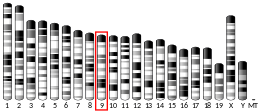LOXL1
Lysyl oxidase homolog 1, also known as LOXL1, is an enzyme which in humans is encoded by the LOXL1 gene.[5][6]
Function
This gene encodes a member of the lysyl oxidase gene family. The prototypic member of the family is essential to the biogenesis of connective tissue, encoding an extracellular copper-dependent amine oxidase that catalyses the first step in the formation of crosslinks in collagens and elastin. A highly conserved amino acid sequence at the C-terminus end appears to be sufficient for amine oxidase activity, suggesting that each family member may retain this function. The N-terminus is poorly conserved and may impart additional roles in developmental regulation, senescence, tumor suppression, cell growth control, and chemotaxis to each member of the family.[5]
Clinical significance
Polymorphisms of the LOXL1 gene are associated with pseudoexfoliation syndrome, a disease where the extracellular matrix contains abnormal amounts of cross-linked, amyloid-like fibrillar material and glycoproteins. When this happens in the eye, exfoliation glaucoma results.[7][8]
Interactions
LOXL1 has been shown to interact with FBLN5.[9]
References
- GRCh38: Ensembl release 89: ENSG00000129038 - Ensembl, May 2017
- GRCm38: Ensembl release 89: ENSMUSG00000032334 - Ensembl, May 2017
- "Human PubMed Reference:". National Center for Biotechnology Information, U.S. National Library of Medicine.
- "Mouse PubMed Reference:". National Center for Biotechnology Information, U.S. National Library of Medicine.
- "Entrez Gene: LOXL1 lysyl oxidase-like 1".
- Kenyon K, Modi WS, Contente S, Friedman RM (September 1993). "A novel human cDNA with a predicted protein similar to lysyl oxidase maps to chromosome 15q24-q25". The Journal of Biological Chemistry. 268 (25): 18435–7. PMID 7689553.
- Schlötzer-Schrehardt U, Naumann GO (2006). "Ocular and systemic pseudoexfoliation syndrome". Am. J. Ophthalmol. 141 (5): 921–937. doi:10.1016/j.ajo.2006.01.047. PMID 16678509.
- Thorleifsson G, Magnusson KP, Sulem P, Walters GB, Gudbjartsson DF, Stefansson H, Jonsson T, Jonasdottir A, Jonasdottir A, Stefansdottir G, Masson G, Hardarson GA, Petursson H, Arnarsson A, Motallebipour M, Wallerman O, Wadelius C, Gulcher JR, Thorsteinsdottir U, Kong A, Jonasson F, Stefansson K (2007). "Common sequence variants in the LOXL1 gene confer susceptibility to exfoliation glaucoma". Science. 317 (5843): 1397–400. Bibcode:2007Sci...317.1397T. doi:10.1126/science.1146554. PMID 17690259.
- Liu X, Zhao Y, Gao J, Pawlyk B, Starcher B, Spencer JA, Yanagisawa H, Zuo J, Li T (Feb 2004). "Elastic fiber homeostasis requires lysyl oxidase-like 1 protein". Nat. Genet. United States. 36 (2): 178–82. doi:10.1038/ng1297. ISSN 1061-4036. PMID 14745449.
Further reading
- Csiszar K (2001). "Lysyl oxidases: a novel multifunctional amine oxidase family". Prog. Nucleic Acid Res. Mol. Biol. Progress in Nucleic Acid Research and Molecular Biology. 70: 1–32. doi:10.1016/S0079-6603(01)70012-8. ISBN 978-0-12-540070-1. PMID 11642359.
- Kagan HM, Li W (2003). "Lysyl oxidase: properties, specificity, and biological roles inside and outside of the cell". J. Cell. Biochem. 88 (4): 660–72. doi:10.1002/jcb.10413. PMID 12577300.
- Molnar J, Fong KS, He QP, Hayashi K, Kim Y, Fong SF, Fogelgren B, Szauter KM, Mink M, Csiszar K (2003). "Structural and functional diversity of lysyl oxidase and the LOX-like proteins". Biochim. Biophys. Acta. 1647 (1–2): 220–4. doi:10.1016/s1570-9639(03)00053-0. PMID 12686136.
- Kenyon K, Modi WS, Contente S, Friedman RM (1993). "A novel human cDNA with a predicted protein similar to lysyl oxidase maps to chromosome 15q24-q25". J. Biol. Chem. 268 (25): 18435–7. PMID 7689553.
- Kim Y, Boyd CD, Csiszar K (1995). "A new gene with sequence and structural similarity to the gene encoding human lysyl oxidase". J. Biol. Chem. 270 (13): 7176–82. doi:10.1074/jbc.270.13.7176. PMID 7706256.
- Goy A, Gilles F, Remache Y, Zelenetz AD (2000). "Physical linkage of the lysyl oxidase-like (LOXL1) gene to the PML gene on human chromosome 15q22". Cytogenet. Cell Genet. 88 (1–2): 22–4. doi:10.1159/000015477. PMID 10773658.
- Jung ST, Kim MS, Seo JY, Kim HC, Kim Y (2004). "Purification of enzymatically active human lysyl oxidase and lysyl oxidase-like protein from Escherichia coli inclusion bodies". Protein Expr. Purif. 31 (2): 240–6. doi:10.1016/S1046-5928(03)00217-1. PMID 14550642.
- Liu X, Zhao Y, Gao J, Pawlyk B, Starcher B, Spencer JA, Yanagisawa H, Zuo J, Li T (2004). "Elastic fiber homeostasis requires lysyl oxidase-like 1 protein". Nat. Genet. 36 (2): 178–82. doi:10.1038/ng1297. PMID 14745449.
- Noblesse E, Cenizo V, Bouez C, Borel A, Gleyzal C, Peyrol S, Jacob MP, Sommer P, Damour O (2004). "Lysyl oxidase-like and lysyl oxidase are present in the dermis and epidermis of a skin equivalent and in human skin and are associated to elastic fibers". J. Invest. Dermatol. 122 (3): 621–30. doi:10.1111/j.0022-202X.2004.22330.x. PMID 15086544.
- Thomassin L, Werneck CC, Broekelmann TJ, Gleyzal C, Hornstra IK, Mecham RP, Sommer P (2006). "The Pro-regions of lysyl oxidase and lysyl oxidase-like 1 are required for deposition onto elastic fibers". J. Biol. Chem. 280 (52): 42848–55. doi:10.1074/jbc.M506832200. PMID 16251195.
- Cenizo V, André V, Reymermier C, Sommer P, Damour O, Perrier E (2007). "LOXL as a target to increase the elastin content in adult skin: a dill extract induces the LOXL gene expression". Exp. Dermatol. 15 (8): 574–81. doi:10.1111/j.1600-0625.2006.00442.x. PMID 16842595.
- Thorleifsson G, Magnusson KP, Sulem P, Walters GB, Gudbjartsson DF, Stefansson H, Jonsson T, Jonasdottir A, Jonasdottir A, Stefansdottir G, Masson G, Hardarson GA, Petursson H, Arnarsson A, Motallebipour M, Wallerman O, Wadelius C, Gulcher JR, Thorsteinsdottir U, Kong A, Jonasson F, Stefansson K (2007). "Common sequence variants in the LOXL1 gene confer susceptibility to exfoliation glaucoma". Science. 317 (5843): 1397–400. Bibcode:2007Sci...317.1397T. doi:10.1126/science.1146554. PMID 17690259.
- Damji KF (2007). "Progress in understanding pseudoexfoliation syndrome and pseudoexfoliation-associated glaucoma". Can. J. Ophthalmol. 42 (5): 657–8. doi:10.3129/I07-158. PMID 17891191.




